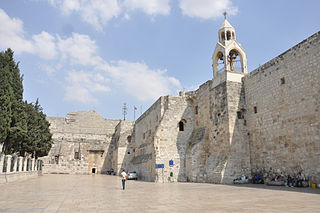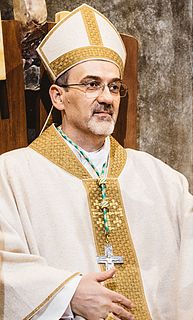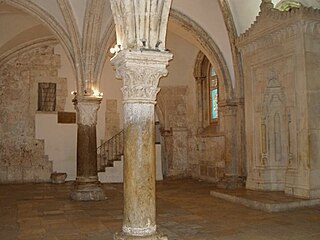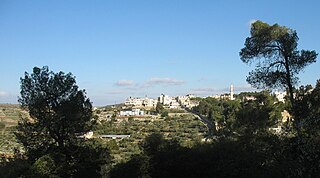
The Church of the Holy Sepulchre is a church in the Christian Quarter of the Old City of Jerusalem. Each time it was rebuilt, some of the antiquities from the preceding church were used in the newer renovation or construction.

The Church of the Nativity, or Basilica of the Nativity, is a basilica located in Bethlehem in the West Bank, Palestine. The grotto it contains holds a prominent religious significance to Christians of various denominations as the birthplace of Jesus. The grotto is the oldest site continuously used as a place of worship in Christianity, and the basilica is the oldest major church in the Holy Land.

The Latin Patriarchate of Jerusalem is the Latin Catholic ecclesiastical patriarchate in Jerusalem, officially seated in the Church of the Holy Sepulchre. It was originally established in 1099, with the Kingdom of Jerusalem encompassing the territories in the Holy Land newly conquered by the First Crusade. From 1374 to 1847 it was a titular see, with the patriarchs of Jerusalem being based at the Basilica di San Lorenzo fuori le Mura in Rome. A resident Latin patriarch was re-established in 1847 by Pius IX.

The Church of All Nations, also known as the Church or Basilica of the Agony, is a Roman Catholic church located on the Mount of Olives in East Jerusalem, next to the Garden of Gethsemane. It enshrines a section of bedrock where Jesus is said to have prayed before his arrest.

Cleopas, also spelled Cleophas, was a figure of early Christianity, one of the two disciples who encountered Jesus during the Road to Emmaus appearance in Luke 24:13–32.

Mount Nebo is an elevated ridge located in Jordan, approximately 710 metres (2,330 ft) above sea level. Part of the Abarim mountain range, Mount Nebo is mentioned in the Bible as the place where Moses was granted a view of the Promised Land before his death. The view from the summit provides a panorama of the West Bank across the Jordan River valley. The city of Jericho is usually visible from the summit, as is Jerusalem on a very clear day. The biblical town of Nebo, now known as Khirbet al-Mukhayyat, is located 3.5 km away.

Emmaus is a town mentioned in the Gospel of Luke of the New Testament. Luke reports that Jesus appeared, after his death and resurrection, before two of his disciples while they were walking on the road to Emmaus.

The Cenacle, also known as the Upper Room, is a room in Mount Zion in Jerusalem, just outside the Old City walls, traditionally held to be the site of the Last Supper, the final meal that, in the Gospel accounts, Jesus held with the apostles.

The Church of the Annunciation, sometimes also referred to as the Basilica of the Annunciation, is a Catholic church in Nazareth, in northern Israel. It was established over what Catholic tradition holds to be the site of the house of the Virgin Mary, and where the angel Gabriel appeared to her and announced that she would conceive and bear the Son of God, Jesus – an event known as the Annunciation.

The Catholic Church in Israel is part of the worldwide Catholic Church, in full communion with the Holy See in Rome.

Imwas or Emmaus, known in classical times as Nicopolis, was a Palestinian Arab village located 12 kilometres (7.5 mi) southeast of the city of Ramla and 26 kilometres (16 mi) from Jerusalem in the Latrun salient of the West Bank. It is traditionally identified with the biblical Emmaus.

The Greek Orthodox Church of the Annunciation, also known as the Greek Orthodox Church of Saint Gabriel, is an Eastern Orthodox church in Nazareth, Israel. Likely first established in Byzantine-era Palaestina Prima, it was rebuilt during the time of the Crusades, and again in the 18th century under the rule of Zahir al-Umar, the Arab governor of the Galilee.

The Tomb of Lazarus is a traditional spot of pilgrimage located in the West Bank town of al-Eizariya, traditionally identified as the biblical village of Bethany, on the southeast slope of the Mount of Olives, some 2.4 km east of Jerusalem. The tomb is the purported site of a miracle recorded in the Gospel of John in which Jesus raised Lazarus from the dead.

Nicopolis was the name of Emmaus under the Roman Empire until the conquest of Palestine by the Rashidun Caliphate in 639. The Church Fathers unanimously considered this city to be the Emmaus of the New Testament where Jesus was said to have appeared after his death and resurrection; it is sometimes distinguished from other Emmauses of Palestine and other Nicopolises of the Roman Empire by the combined name Emmaus Nicopolis or Emmaus-Nicopolis. The site of the ancient city now lies between Tel Aviv and Jerusalem in Israel. A Palestinian Arab village occupied the site until the Six-Day War in 1967, when it was destroyed. The archaeological site has been cared for by a resident French Catholic community since 1993 but are formally organized as a part of Canada Park under the general supervision of the Israel Nature and Parks Authority.

Al-Qubeiba is a Palestinian village in the Jerusalem Governorate, located 11 kilometers Northwest of Jerusalem in the central West Bank. According to the Palestinian Central Bureau of Statistics, the village had a population of 3,321 in 2010. Al-Qubeiba lies at an altitude of 783m to 795m above sea-level. It is located in a conflict area near the border with Israel between Ramallah and Jerusalem. The settlement of Giv'on HaHadashah lies 5 km southeast of al-Qubeiba. It is surrounded by the town of Biddu (east), Beit 'Anan (northwest), Qatanna (southwest), and Kharayib Umm al-Lahim (west). Unlike the surrounding region, al-Qubeiba has large areas covered with pine and olive trees.

The Church of Saint Anne is a French Roman Catholic church and French national domain located at before start of the Via Dolorosa, between the Lions' Gate and of the Second Station of the Cross, in the Muslim Quarter of the Old City of Jerusalem.

The Benedictine monastery in Abu Ghosh is a monastery run by the Olivetan Benedictine order in Abu Ghosh, Israel.

The Shepherds' Field Chapel > or the Sanctuary of the Gloria in excelsis Deo, dedicated to Our Lady of Fatima and St. Theresa of Lisieux, is a Roman Catholic religious building. in the area of Beit Sahour, southeast of Bethlehem in the West Bank in Palestine. The chapel marks the place where, according to Catholic tradition, angels first announced the birth of Christ.

The Diocese of Emmaus is an ancient and titular diocese of the Roman Catholic Church, located in Emmaus/Nicopolis, Israel,. The current bishop is Giacinto-Boulos Marcuzzo who resides in Nazareth.




















